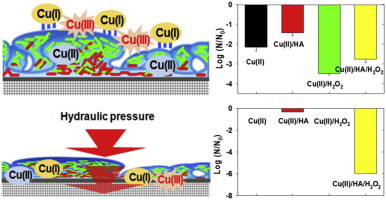Abstract
Combinations of Cu(II) with hydroxylamine (HA) and hydrogen peroxide (H2O2) (i.e., Cu(II)/HA, Cu(II)/H2O2, and Cu(II)/HA/H2O2 systems) were investigated for the control of P. aeruginosa biofilms on reverse osmosis (RO) membranes. These Cu(II)-based disinfection systems effectively inactivated P. aeruginosa cells, exhibiting different behaviors depending on the state of bacterial cells (planktonic or biofilm) and the condition of biofilm growth and treatment (normal or pressurized condition). The Cu(II)/HA and Cu(II)/HA/H2O2 systems were the most effective reagents for the inactivation of planktonic cells. However, these systems were not effective in inactivating cells in biofilms on the RO membranes possibly due to the interactions of Cu(I) with extracellular polymeric substances (EPS), where biofilms were grown and treated in center for disease control (CDC) reactors. Different from the results using CDC reactors, in a pressurized cross-flow RO filtration unit, the Cu(II)/HA/H2O2 treatment significantly inactivated biofilm cells formed on the RO membranes, successfully recovering the permeate flux reduced by the biofouling. The pretreatment of feed solutions by Cu(II)/HA and Cu(II)/HA/H2O2 systems (applied before the biofilm formation) effectively mitigated the permeate flux decline by preventing the biofilm growth on the RO membranes.
